Category: Hunting Blog
Better Fruit Trees, Better Hunting
We all know the attractiveness of fruit trees for wildlife, but it becomes even more clear when they’re spending the night standing in the yard just to eat fruit! Earlier this week I placed a Reconyx camera next to a couple peach trees I suspected deer to be using. These two trees are bearing a lot of fruit and are a great reminder of the advantages to having tree plots!
- Deer love high quality fruit from a tree plot!
- Pruning is very important in improving the quality and life of a fruit tree.
- Tree plots can create a hunting hot spot.
- Selecting the appropriate species, finding the right location and maintaining the trees are all factors in great tree plots!
For love of the land and Glory to God,
Adam
How To Create Cover For Wildlife
Last week we discussed how the use of prescribed fire in the timber can increase the amount of native vegetation available to the wildlife. This week we dive deeper into what prescribed fire can offer. We use this tool to increase both poult and fawn survival rates. Native vegetation provides a canopy of cover that poults easily walk underneath. This shelters poults from the many predators from above. Removing the duff layer exposes small insects, bugs, and grubs. This allows poults to feed and move safely in these areas. Deer live their lives between ground level and the three foot mark. The vegetation in the burn unit is already several feet tall, making these areas much more attractive to fawns and mature deer. What was an area of limited productivity is now converted into habitat that will benefit many forms of wildlife in multiple ways.
GrowingDeer together,
Matt
Creating Native Food Plots
When the conditions allow for a prescribed fire, we burn! During the late winter, we use prescribed fire in our timber areas. These fires burn slow and remove the duff layer on the forest floor. Throughout the spring, the sunlight hits the ground floor and germination of native early successional vegetation begins. This vegetation is ideal, full of nutrition and diversity. Prescribed fire during the right time of the year creates a native food plot in our timber! To get the most out of your land requires maximizing every acre!
GrowingDeer together,
Matt
Better Soil Equals Healthier Deer
First things first, we must understand that it all starts at ground level. Healthy soil contains essential nutrients and minerals. These elements are taken up by plants through their root systems. Plants transfer those nutrients and minerals to deer that consume them. Our Eagle Seed soybeans are transfer agents for those elements contained in the soil. Poor soil will limit the amount of genetic potential a deer can express. This is why we take soil samples each season to continue improving our soil, ultimately growing larger antlers and healthier deer.
GrowingDeer together,
Matt
Watching Antlers: Preparing For Bow Season
It’s that time of the year when we are changing gears. Missouri’s turkey season just closed. We are not only getting more sleep at night, but also dreaming of whitetails. Our Reconyx cameras have been capturing photos of great antler development here at The Proving Grounds. This is very exciting! We will enjoy watching bucks develop within the next couple months.
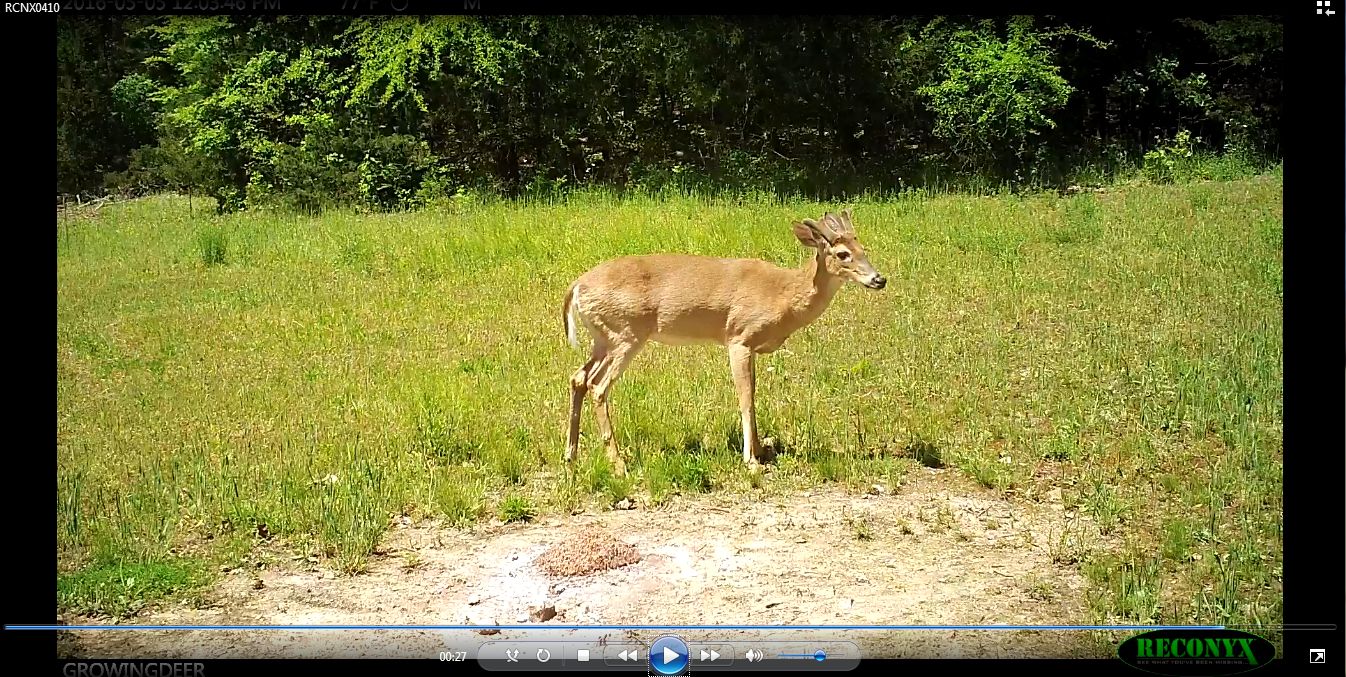
This buck is off to a great start. You can bet we will keep our eye on him this summer!
This is an important time of the year. We take a few additional measures now to better prepare ourselves for hunting season. At this time of the year we move our Reconyx cameras from turkey strut zones to food plots and established Trophy Rock mineral sites. The recently planted Eagle Seed beans will soon attract deer. Positioning cameras on these plots allows us to watch feeding patterns during the summer. Learning these patterns early on can assist as opening day arrives. States with early bow openers like Kentucky, Maryland, or Wyoming have an advantage if summer feeding patterns are identified as season opens.
Mineral sites serve multiple purposes for us. Both bucks and does regularly use mineral locations throughout the summer. These locations are ideal for Reconyx cameras as well. Trophy Rock provides macro and micro trace elements to the local deer herd. As bucks develop their antlers this supply of minerals increases antler growth. This is a stressful time for does as they are dropping fawns and lactating over the next several months. Lactating requires a healthy diet plus additional nutrients to supply to young fawns. Trophy Rock can supply those necessary elements.
Placing cameras over food plots and Trophy Rock locations is a great way to build anticipation. Antler development is occurring while fawns are beginning to drop. Our cameras are in place to capture this all! We are excited to start cataloging bucks! It is a great time of the year for a deer manager.
GrowingDeer together,
Matt
Strategic Food Plot Management
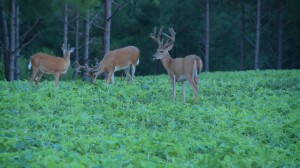
Soybeans are easy to grow about anywhere and provide great nutrition for deer.
This week has been an important week for us here at GrowingDeer. It’s not only the last week of turkey season, but the Eagle Seed soybeans are going in the dirt! Planting season is here. With that comes an appreciation of the hard work put in months ago.
Last August we planted many of our food plots in the Broadside blend. This is a fall mixture of soybeans, wheat, turnips, and radishes. This variety helped feed the wildlife throughout the winter. The Broadside has now been terminated in preparation for the new soybeans. Even though the Broadside is no longer living that doesn’t mean it does not serve a purpose.
As we are drilling the new soybeans into the Broadside blend it is laying down on top of the soil. This is all part of the plan! With the vegetation covering the soil, critical soil moisture is conserved. The long range forecast of rain is nearly impossible to predict. Rain could be a few days or weeks away. It’s important to take steps to conserve soil moisture. In addition, the vegetation is shading the ground. This helps to fend off weed growth or competition with the newly planted soybeans. Since the Broadside blend has been terminated it will slowly begin to breakdown. As it does this, nutrients will leach back into the soil. When this happens those nutrients are readily available for the new soybeans to uptake and benefit from.
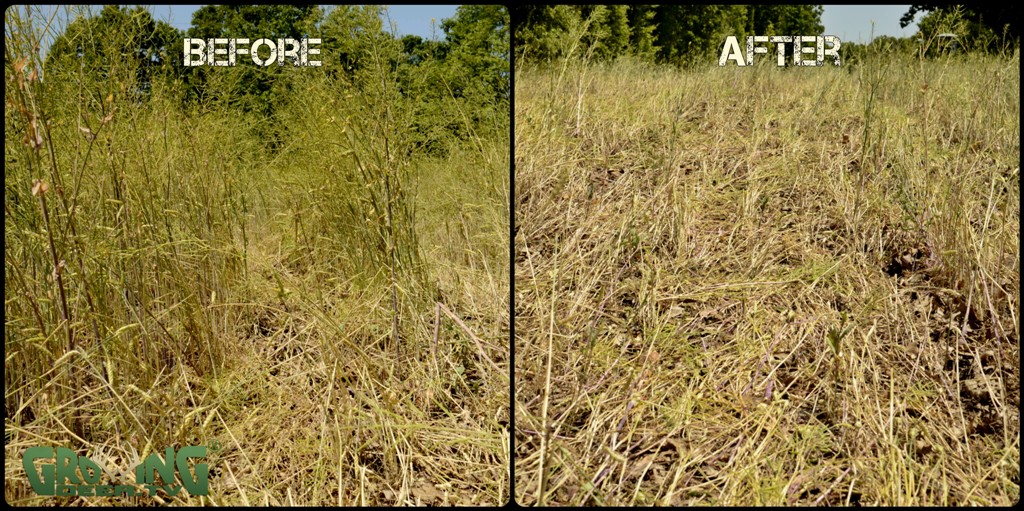
Simply planting a fall blend in your food plots and following this strategy can increase productivity in your next crop. The better the soil the better food plots will grow. When food plots are more productive the quality of the local deer herd will increase. Deer management should start at “ground level”.
Managing deer together,
Matt
Full Foliage Turkey Tactics
Many states will see the arrival of spring during a portion of their turkey season. Throughout the season the conditions can change drastically. You may hunt early on when no leaves are present. Then, within two weeks the trees are in full foliage. This is certain to change the hunt, but how should your tactics change?
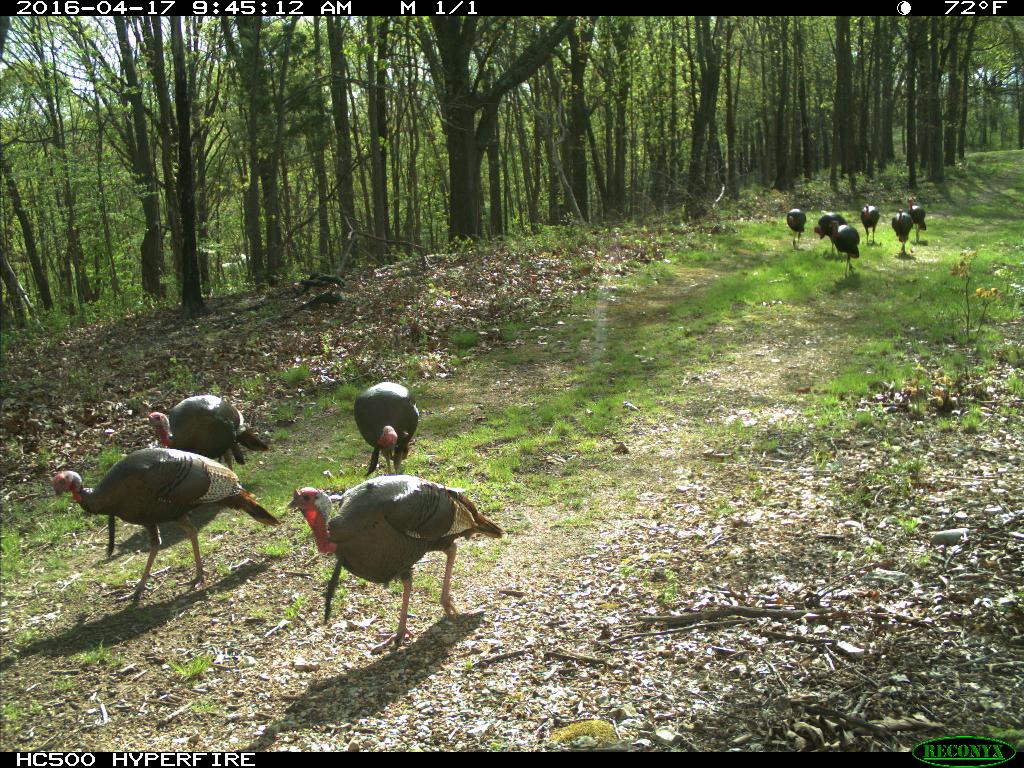
Visibility in timber will soon be limited! Don’t let that keep you from turkey hunting.
First things first, full foliage will drastically affect the way sounds carries. There are many more obstacles in the woods to deflect and absorb sound waves. When you call to a tom, the sound will not carry as far as it would have in the early season. In the same regards, his gobbles may make him sound further away than he actually is. This principle is important to keep in mind when working a bird. Be mindful of the actual distance the bird is from your location. Be natural and do not call too loudly or “sound blast” a gobbler. Calling too loudly when a bird is in close proximity can shut him down. Calling like this is a warning siren to him.
When trees are leafed out, gobblers are forced to search a little more while working through the timber. When underbrush has not leafed out and terrain allows, a longbeard can see further. This may result in birds hanging up out of range. When full foliage occurs, the gobbler is forced to investigate the scene more. His long distance views are now restricted. He is more willing to spend time searching for the hen. This means closing the distance to your setup.
Do not be discouraged by the progression of spring. Gobblers may seem more distant, but calling at the appropriate volumes will increase your success. Even with a limited view, this can work to your advantage. A lonely tom will search for that hen. Take advantage of the hens sitting on nests during the late season. Find a lonely tom, hunt hard and smart.
Chasing longbeards together,
Matt
Limited Vacation and Tags to Fill
It’s true work gets in the way of turkey season! Sometimes there is no way around it. It can be nearly impossible to take off every morning to enjoy a hunt. What should the approach be to turkey season when you have limited days to fill tags?
Opening day, you just can’t resist going out! There is something magical about opening morning that gets you out of bed and in the woods. If you are like me and cannot resist, then hunt. But when you do scout very intently. What you learn then will be used later. Take notice of the exact locations where birds are roosting. After fly down, remember which ways they travel and what they are traveling to. Opening morning birds can be tough to kill. Longbeards usually have hens with them. The gobbler may simply follow the flock, gobbling every so often. After you have the first day jitters worked out and the scouting report, stay out of the woods.
Here in Missouri our season is only three weeks long. With a few vacation days remaining I’d wait for late into week two or even week three to take off again. Gobblers will most likely be breeding hens for some time. When time is limited don’t waste it calling to henned up gobblers. Let them breed their hens. Then they will begin searching for hens. This is the time when gobblers become more responsive to the call. By this time many hens are out searching to find a location to nest or sitting on their nest already. This makes for lonely, responsive gobblers.
Your opening day scouting report can help determine where the birds are roosting. You know the general area of where to start your hunt. Once that bird sounds off, you also have a good idea of where they are likely to travel to. Setup and let the show come to you! Plan your days in the turkey woods accordingly. Learn early, then get in and hunt when the odds are more in your favor. Don’t let minimal vacation days stop you from filling your tags!
Chasing longbeards,
Matt
How To Setup On A Gobbler
You hear a bird on the roost and you start to close in on his location. Immediately you think where can I setup? How close can I get? You want to be close enough to peak the gobbler’s interest but not risk spooking him.
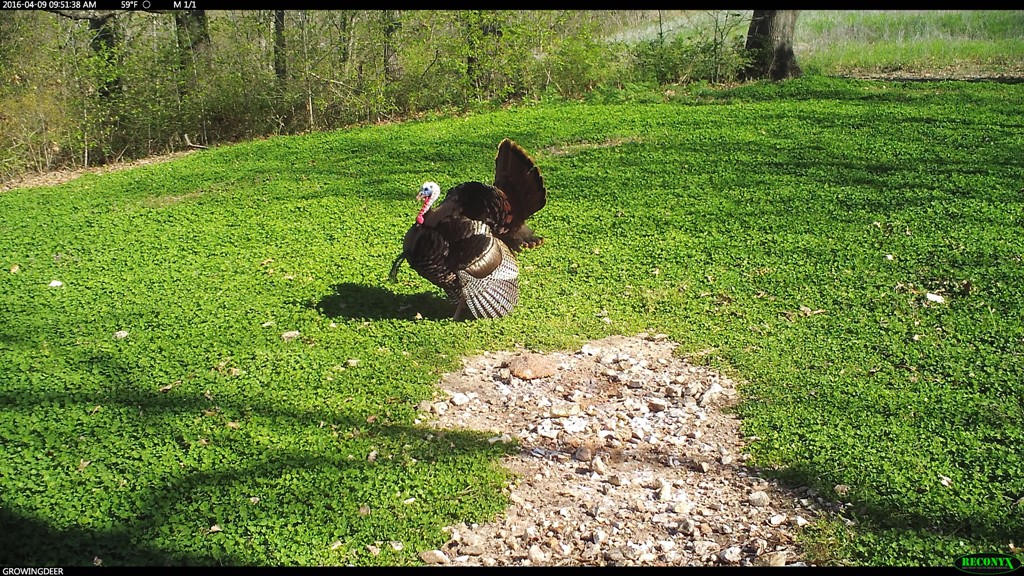
A strutting tom works a narrow ridge on a small clover plot.
After hearing a bird on the roost there are some general rules that I follow as I setup. First off, I map out the gobblers route to me. I imagine how he would make his way to me. The gobbler will work in using the terrain to his advantage. From here I make my first move. This may mean circling completely around the gobbler.
After doing my best to predict the route he may take, I determine where I want to setup along that route. I look for visibility, but cover as well. I want to have a shot opportunity but I do not want to be sitting in the wide open. I also do not like to setup close to the edge of a ridge. These places are great ambush points for predators. A turkey coming into the call will likely circle you or hang up if he is forced into this situation. Each setup I ensure visibility, cover, and room for the bird to work in as he finishes.
I look for all of the factors above to be about 200 yards away from the roost tree. Getting in to tight to the roost tree limits the gobbler’s approach to you. If you crowd him on the roost he is more likely to circle you. Another reason to stay further back is that if you need to move your setup, you have the room to do so. Your setup should not handcuff yourself nor the turkey.
The 200 yard mark allows my soft tree yelps at first light to carry to the roost tree. I simply let the gobbler know where I am. From that point on my other calls will hopefully convince him to come. The bird has the terrain to his advantage and room to work in while I have visibility and cover. If I can coax him within range of a Long Beard XR round, this usually means I punch a tag.
Chasing longbeards together,
Matt
Turkey Hunting: 5 Tips To Tag A Tom In The Late Morning
Hunting a bird right off the roost can be tough! Naturally, they wait for the hens to come to their roost tree. Hunters try to reverse this and entice a gobbler to come to them. If you’ve experienced this you may wonder, is the hunt over after a gobbler flies down and gets with hens? How do I remain successful when I don’t harvest a gobbler off the roost?
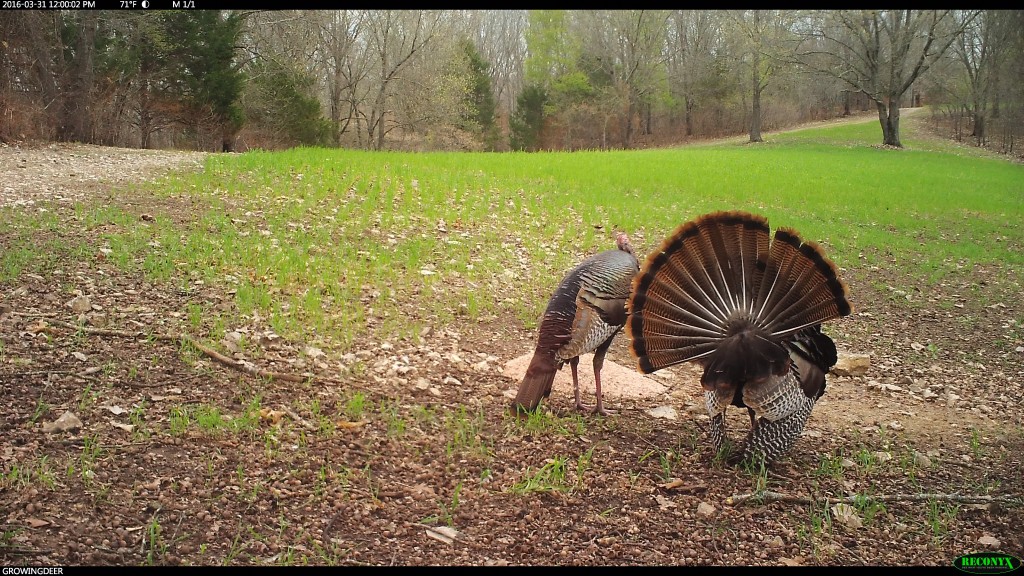
These lonely gobblers make prime candidates to chase during a late morning hunt!
The hunt is not over, unless your honey-do list is long. If you can remain patient your chances of success increase. Once a gobbler has flown down and met his hens, do your best to keep him gobbling. This isn’t to call him in. It’s simply to keep tabs on his location. Turkeys can cover a lot of ground quickly. Using a crow call (watch a short video of calling here) during this time of the hunt works well. As the season progresses and hens are bred, they will begin to search for nesting locations. Hens may fly down and congregate with other turkeys but then soon leave. This means gobblers are left alone. A lonely gobbler is a good gobbler to have in your turkey woods.
Keeping the gobbler vocal allows you to make the appropriate setup once his hens have left. Toms may begin to gobble on their own once this occurs. They are lonely making this is your time to strike! Gobblers are already on their feet and searching for the hens to accompany them.
To put the odds further in your favor, your setup should be very approachable. Do not force that gobbler to walk down a hill or through a tight pinch point. If you do, he will most likely circle behind you or hang-up out of range. Instead make his approach a safe one. This may mean getting your boots moving to circle behind him. Get to where the terrain allows him to close the distance safely. Even though this bird wants to be with a hen, he wants to survive. You’ve been patient all morning; take the extra time to get setup correctly.
Hunting longbeards mid-morning can be extremely successful. Do not give up on the gobbler if you don’t bag him at first light. Stay persistent and keep him gobbling. Waiting a turkey out until he is lonely is often a recipe for success.
Chasing longbeards together,
Matt



